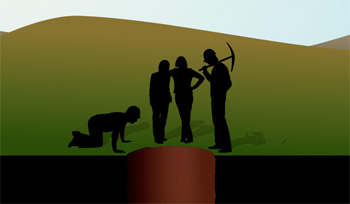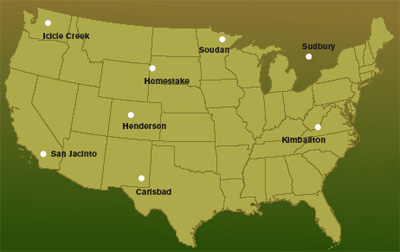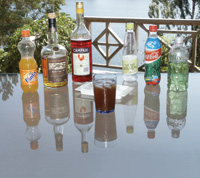Science from a hole in the ground
by Judy Jackson
|
|
"Alice started to her feet, for it flashed across her mind that she had never before seen a rabbit with either a waistcoat-pocket, or a watch to take out of it, and burning with curiosity, she ran across the field after it, and fortunately was just in time to see it pop down a large rabbit-hole under the hedge. In another moment down went Alice after it..."
Lewis Carroll, "Down the Rabbit Hole," from
Alice's Adventures in Wonderland
When Alice famously went down the rabbit hole, she ended up in Wonderland. Now, a group of US scientists from fields as diverse as microbiology and particle physics, rock mechanics and molecular evolution are proposing to go down their own version of the rabbit hole into the scientific wonderland of a Deep Underground Science and Engineering Laboratory. In response to a National Science Foundation (NSF) solicitation, scientists and engineers from a spectrum of scientific disciplines are at work on a six-month effort to define a set of scientific goals that can only be achieved in experiments far below the surface of the earth.
|
|
Notes from Underground
They may not meet the Queen of Hearts, but the DUSEL scientists will be joining an illustrious company of underground researchers. Recent experiments at the Sudbury Neutrino Observatory, 6800 feet underground in a nickel mine in Sudbury, Ontario, for example, helped to establish the existence of neutrino mass by their confirmation of the morphing of one type of neutrino to another. The SNO research is a direct descendent of another famous underground neutrino experiment led by US physicist Raymond Davis, Jr. In 2002, Davis shared the Nobel Prize "for pioneering contributions to astrophysics, in particular for the detection of cosmic neutrinos." Beginning in 1970, Davis's neutrino detector shared space with mining operations at the Homestake Gold Mine in Lead, South Dakota, where his detector, 4850 feet below ground, revealed that fewer neutrinos than expected were reaching Earth from the sun.
| "Science First! Before you tell me what you want to build, tell me the questions you want to answer." Michael Turner Assistant Director, National Science Foundation, Directorate for Mathematical and Physical Sciences |
When the Barrick Gold Corporation, owner of the Homestake Mine, ceased mining operations there in 2001, US scientists hoped to turn Homestake into a dedicated underground laboratory of the type that several national studies on underground science had recommended. However, negotiations over the transfer of mine ownership to the state of North Dakota foundered, and on June 9, 2003, Barrick turned off the pumps at Homestake, allowing water to begin accumulating in the mine's underground tunnels.
|
|
Back to Square One
The push for an underground laboratory persisted, however, driven by the unique needs of science underground. Certain neutrino experiments, plagued by cosmic-ray backgrounds, for example, require the kind of shielding that only thousands of feet of rock "overburden" can provide. Microbiologists dream of long-term access to the extraordinary life forms that persist at high temperatures and pressures in the earth's depths, isolated for millennia from the surface. Geologists who study the earth's subsurface using data from surface instruments and bore holes want to know if the "transparent earth" they have modeled matches what's really down there. Experts in rock mechanics want to watch how rock reacts to stress and strain over time in the controlled circumstances of an underground laboratory.
And while piggybacking on mining operations, as at SNO and Homestake, offers an invaluable route to the underworld for scientists, it has drawbacks. Research activities, of necessity, come second to the exigencies of mining operations. Mining equipment tends to disturb pristine micro bial environments and introduce contamination. Long-term access to any one section of the mine is often impossible. And, as the experience at Homestake showed, sometimes the miners turn the pumps off.
"We need a dedicated site," says geomicrobiologist Tom Kieft of New Mexico Tech. "There is only so much to be done piggybacking on mine sites. We're a nuisance for them. In a dedicated facility, we would have long-term access."
So, in 2004, in response to a host of unsolicited proposals that NSF had received for underground laboratories at various sites, the agency announced a two-part solicitation process for a dedicated underground laboratory. To encourage the research community to focus on the best possible scientific outcome, Solicitation One called for a site-independent proposal for "unique experiments that cannot be done at the surface, with multi-user, multi-experiment facilities." Solicitation Two called for suggestions for specific sites.
DUSEL is the effort to develop a single, community-wide, interdisciplinary response to Solicitation One. The project, funded by NSF and led by Lawrence Berkeley National Laboratory astrophysicist Bernard Sadoulet, will report to NSF in September 2005. Officials of NSF say they plan to request federal funding for the underground science lab in the FY08 federal budget request.
How old is your drink? |
E Pluribus Unum
The DUSEL proponents have clearly grasped the need for scientific synergy. If they propose to go underground, they must go underground together. The Solicitation One report will group individual scientific "elements" from various disciplines into "modules" of experiments that require similar infrastructure, in terms of depth, square footage, and other parameters. These modules can then be used to evaluate proposals by the individual sites.
Underground modules make strange bedfellows. At a DUSEL workshop in Boulder, Colorado, in January, scientists from particle and nuclear physics, astrophysics, geology, geomicrobiology and rock mechanics strained to grasp each othersjargon, each othersscientific challenges—even each otherssociology. Biologists learned the significance of neutrinoless double beta decay for particle physics (huge); while particle physicists heard about the pace of life deep underground (slo-o-ow).
"Hold it," a particle physicist interrupted during a talk about subsurface life forms. "What's a prokaryote?"
"Well," the speaker said, "it probably means as much to you as neutrino mixing means to me."
What in fact does rock mechanics have to do with a physics experiment? Geology with biology? In the former case, one proposed particle physics detector would require the largest underground cavern ever excavated, a definite challenge for rock mechanics. As for biology and geology, Michigan State University microbiologist James Tiedje uses the term "living rock" to describe the intimate relationship between deep subsurface geology and the microbial life it harbors.
Not all fields have obvious synergy, however; and, in fact, not all are even compatible. A dry site might be great for a physics experiment, but microbiologists need water (especially ancient million-year-old water), because water appears to be necessary for life. Moreover, one depth does not fit all, even among physics experiments. Some (solar neutrinos, double beta decay, for instance) require small volume but great depth, while others (neutrinos oscillation, proton decay) may need lots of space but could be shallower.
Open Questions
As DUSEL scientists prepare their Solicitation One response, they confront significant questions. Can a single underground site meet the requirements of all or most of the experiments, or might it be better and cheaper to choose more than one site? One large laboratory or a distributed laboratory? Under a single management? How closely should the underground laboratory be tied to the construction of a particle accelerator neutrino "factory?" Should a giant particle detector be the centerpiece, or an option? How does a US underground laboratory fit into the international context of underground labs in Asia and Europe? In coming months, scientists will address these and other difficult issues to show that DUSEL indeed knows science from a hole in the ground.
Click here to download the pdf version of this article.










